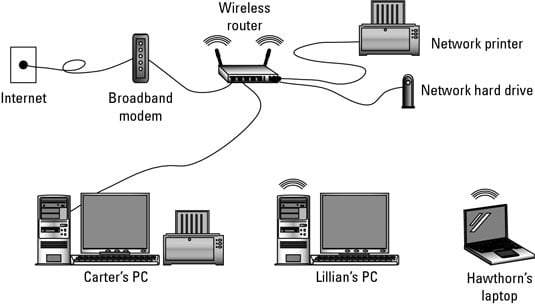As long as you have all the hardware, you can quickly set up any wireless network. Here’s everything you need to know about the hardware you need before you use Windows to configure your wireless network.
There are two types of wireless networks: infrastructure and ad hoc networks. An infrastructure network will most likely be the type of wireless setup you use in your home or office. It is laid out similarly to a wired mesh, but without wires.

A basic peer-to-peer wireless network consists of the following components:
Wireless Router: The heart of a wireless network is a wireless router. Like a wire-based network, a hub is a central location to which all computers are connected, providing computers with access to the network.
Wireless hubs now also act as routers. Well, officially, wireless hubs are gateways, not routers, but they are called routers. They are also known as access points, so get used to that term as well.
Despite the confusion in the naming, all you need to know is that a hub/router/access point is a clever little beast that helps manage wireless connections and also helps connect your wireless network to the Internet.
Wire-based connections: Almost every wireless router has one or more standard wire-based Ethernet ports. One port is used to connect the router to a broadband modem. Other Ethernet ports may also be available, allowing you to connect standard wire-based networks to the wireless hub.
Wireless NIC: The computer needs a wireless network information card, or NIC, to talk to the wireless router. Your laptop comes standard with a wireless NIC, but for a desktop PC, you should get a wireless NIC as an option. It installs internally as an expansion card, or you can use one of the various wireless NICs via USB.
This is largely for the type of wireless network infrastructure.
An ad hoc wireless network type is basically a group of wireless computers connected to each other. A peer network has no central hub or router. Instead, all of its computers can directly access other computers’ files and shared resources. They may or may not have internet access, but that’s not the point of an ad hoc network.
One advantage of a wireless network is that you can mix wired components as needed. If you need more Ethernet ports, for example, just add a switch to your wireless router.
Despite the wireless nature of wireless networking, you still need an Ethernet cable (cord) to connect a wireless router to a broadband modem.
Another advantage of a wireless network is that it is portable. It is much easier to deal with a wireless network than to put together all the bits and pieces of a wired network. If you live in an apartment, or move around a lot, a wireless setup is a good option.
>>> The term AP is often abbreviated as AP. Don’t be confused when you see the words Wireless AP – they simply refer to the access point, not the Associated Press.
>>> A wireless network is often called a WLAN, for wireless local area network.
>>> A wireless network is also referred to as Wi-Fi. It stands for Wireless Fidelity.
>>> Computer gamers often use networks meant to congregate in one place to play games with each other.
